Case Study: Evaluating Info Systems for Coffee Construction Australia
VerifiedAdded on 2021/04/16
|13
|3481
|141
Case Study
AI Summary
This case study analyzes Coffee Construction Australia, a family-owned construction business, and evaluates the potential of implementing various Information Systems to enhance its operations. The report begins with an executive summary outlining the objectives, which include assessing Information Systems and their impact on different functional areas such as sales, marketing, human resources, finance, and quality management. It explores the business value proposition of using best practice Information Systems, examining what competitors use and the benefits they offer, like improved communication, decision-making, and reduced errors. The study delves into the importance of Information Systems in supporting business functional areas and how project managers can utilize them. It highlights the Enterprise Resource Planning (ERP) system as a valuable Information System, covering finance, human resources, sales, marketing, and quality management modules. The report concludes with recommendations for implementing Information Systems to improve Coffee Construction Australia's business practices and productivity, with a focus on overcoming implementation challenges such as infrastructure, cost, and knowledge gaps.
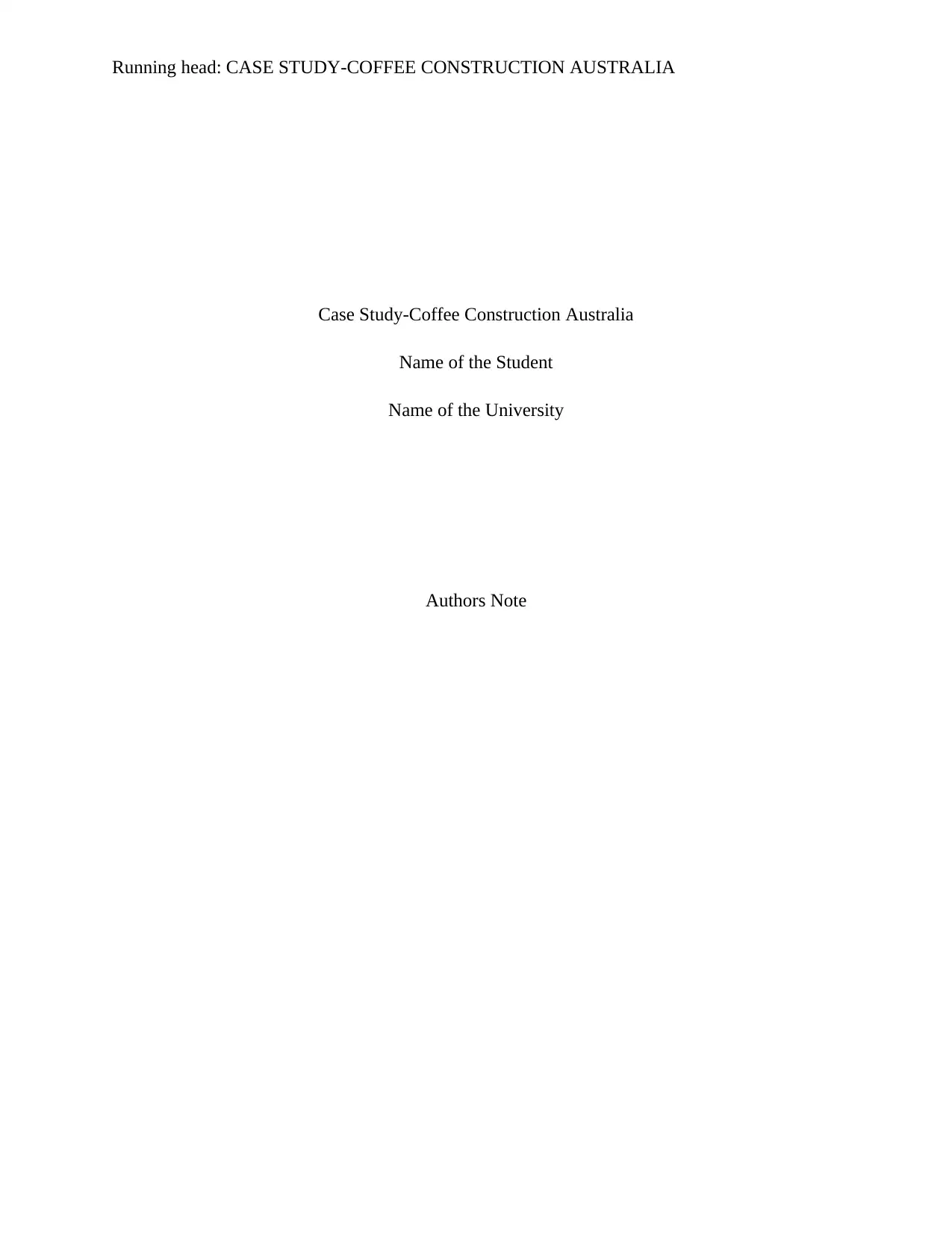
Running head: CASE STUDY-COFFEE CONSTRUCTION AUSTRALIA
Case Study-Coffee Construction Australia
Name of the Student
Name of the University
Authors Note
Case Study-Coffee Construction Australia
Name of the Student
Name of the University
Authors Note
Paraphrase This Document
Need a fresh take? Get an instant paraphrase of this document with our AI Paraphraser
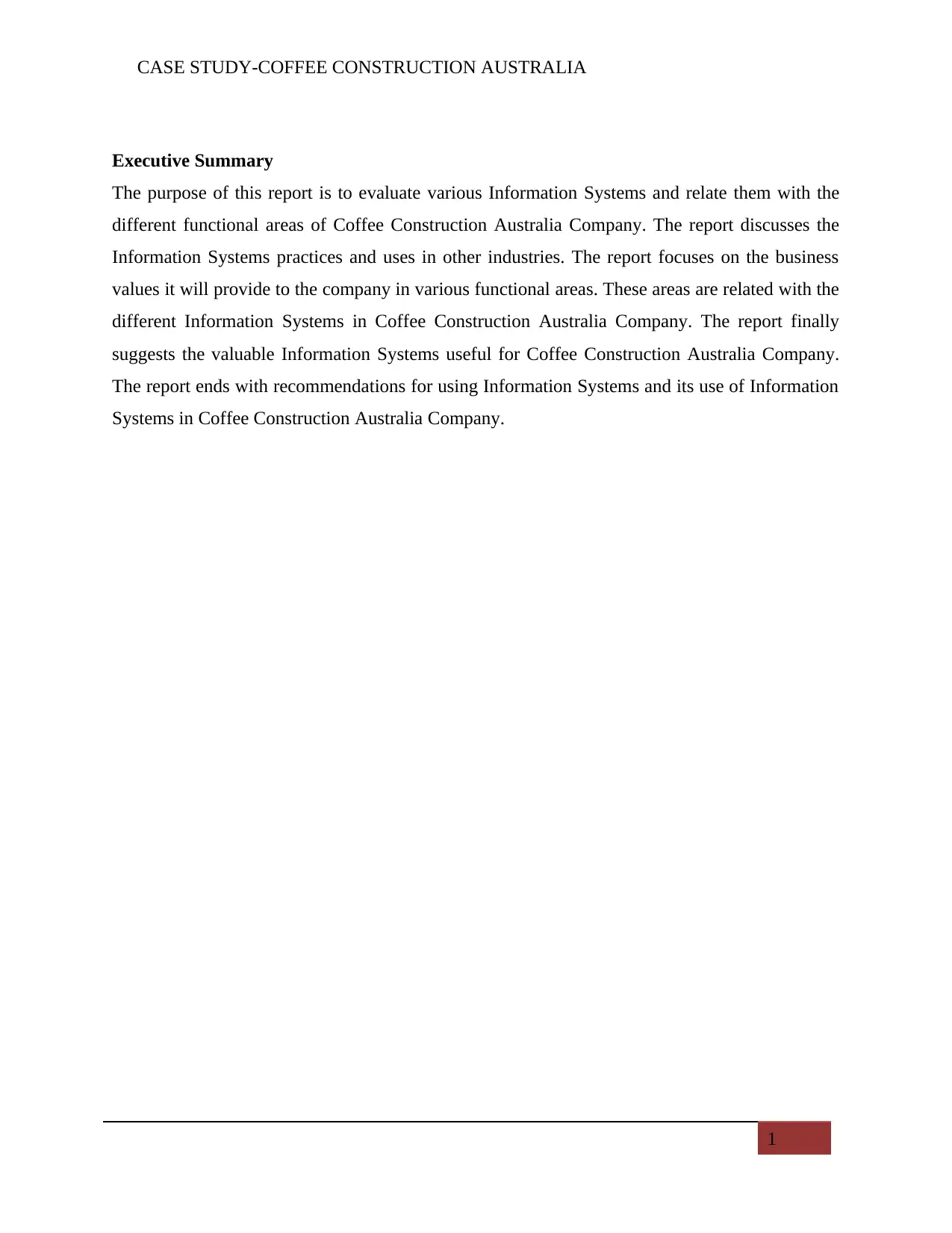
CASE STUDY-COFFEE CONSTRUCTION AUSTRALIA
Executive Summary
The purpose of this report is to evaluate various Information Systems and relate them with the
different functional areas of Coffee Construction Australia Company. The report discusses the
Information Systems practices and uses in other industries. The report focuses on the business
values it will provide to the company in various functional areas. These areas are related with the
different Information Systems in Coffee Construction Australia Company. The report finally
suggests the valuable Information Systems useful for Coffee Construction Australia Company.
The report ends with recommendations for using Information Systems and its use of Information
Systems in Coffee Construction Australia Company.
1
Executive Summary
The purpose of this report is to evaluate various Information Systems and relate them with the
different functional areas of Coffee Construction Australia Company. The report discusses the
Information Systems practices and uses in other industries. The report focuses on the business
values it will provide to the company in various functional areas. These areas are related with the
different Information Systems in Coffee Construction Australia Company. The report finally
suggests the valuable Information Systems useful for Coffee Construction Australia Company.
The report ends with recommendations for using Information Systems and its use of Information
Systems in Coffee Construction Australia Company.
1
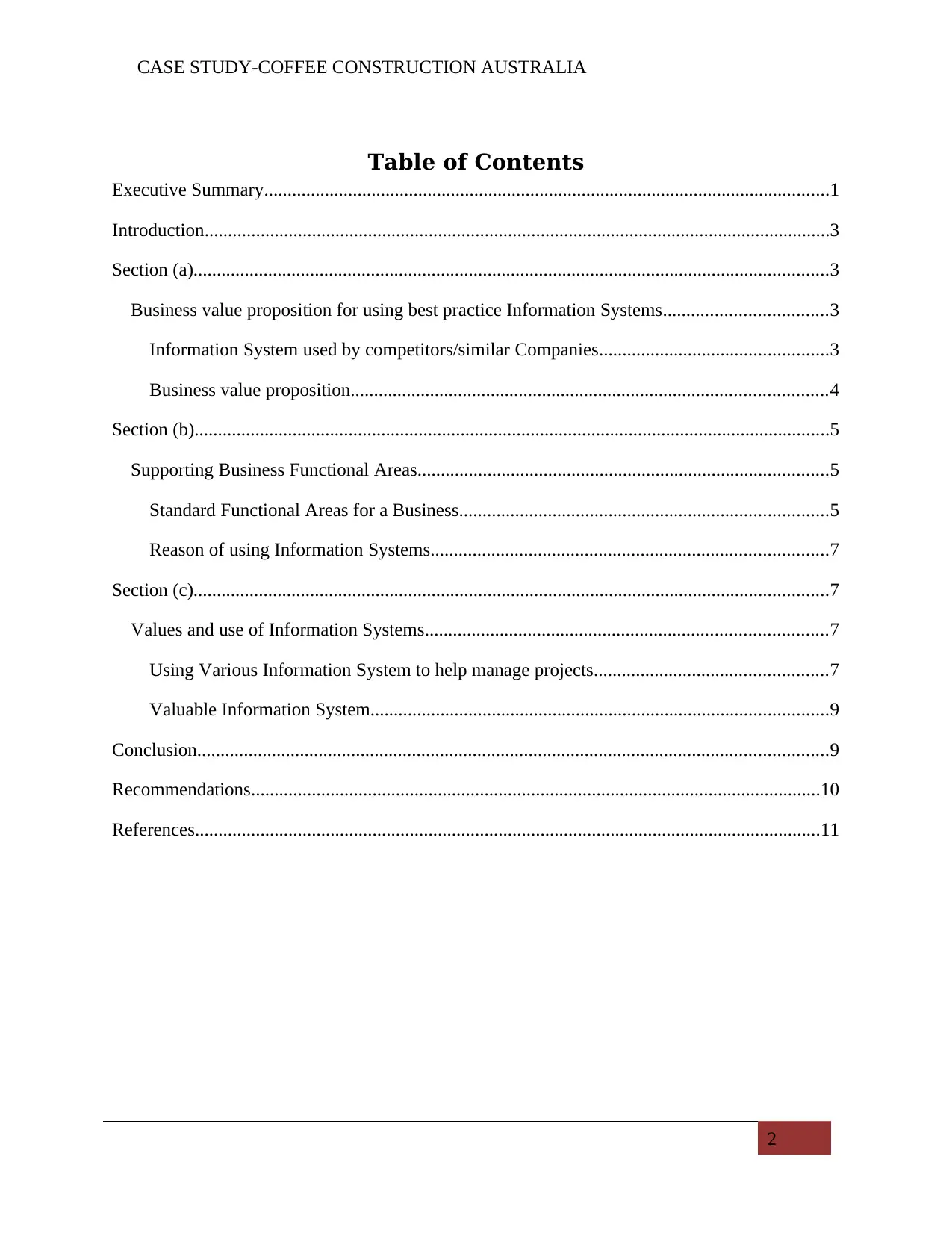
CASE STUDY-COFFEE CONSTRUCTION AUSTRALIA
Table of Contents
Executive Summary.........................................................................................................................1
Introduction......................................................................................................................................3
Section (a)........................................................................................................................................3
Business value proposition for using best practice Information Systems...................................3
Information System used by competitors/similar Companies.................................................3
Business value proposition......................................................................................................4
Section (b)........................................................................................................................................5
Supporting Business Functional Areas........................................................................................5
Standard Functional Areas for a Business...............................................................................5
Reason of using Information Systems.....................................................................................7
Section (c)........................................................................................................................................7
Values and use of Information Systems......................................................................................7
Using Various Information System to help manage projects..................................................7
Valuable Information System..................................................................................................9
Conclusion.......................................................................................................................................9
Recommendations..........................................................................................................................10
References......................................................................................................................................11
2
Table of Contents
Executive Summary.........................................................................................................................1
Introduction......................................................................................................................................3
Section (a)........................................................................................................................................3
Business value proposition for using best practice Information Systems...................................3
Information System used by competitors/similar Companies.................................................3
Business value proposition......................................................................................................4
Section (b)........................................................................................................................................5
Supporting Business Functional Areas........................................................................................5
Standard Functional Areas for a Business...............................................................................5
Reason of using Information Systems.....................................................................................7
Section (c)........................................................................................................................................7
Values and use of Information Systems......................................................................................7
Using Various Information System to help manage projects..................................................7
Valuable Information System..................................................................................................9
Conclusion.......................................................................................................................................9
Recommendations..........................................................................................................................10
References......................................................................................................................................11
2
⊘ This is a preview!⊘
Do you want full access?
Subscribe today to unlock all pages.

Trusted by 1+ million students worldwide
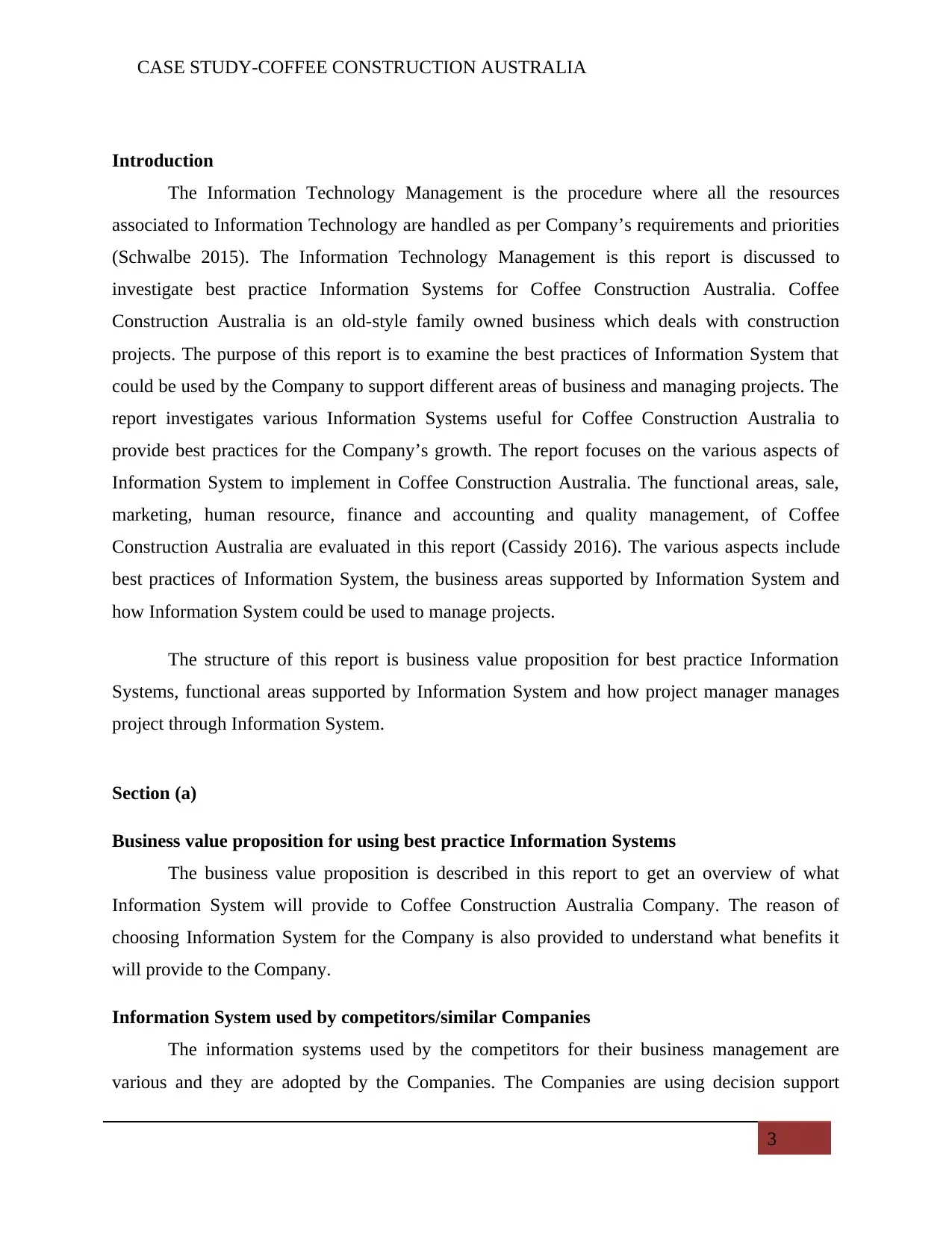
CASE STUDY-COFFEE CONSTRUCTION AUSTRALIA
Introduction
The Information Technology Management is the procedure where all the resources
associated to Information Technology are handled as per Company’s requirements and priorities
(Schwalbe 2015). The Information Technology Management is this report is discussed to
investigate best practice Information Systems for Coffee Construction Australia. Coffee
Construction Australia is an old-style family owned business which deals with construction
projects. The purpose of this report is to examine the best practices of Information System that
could be used by the Company to support different areas of business and managing projects. The
report investigates various Information Systems useful for Coffee Construction Australia to
provide best practices for the Company’s growth. The report focuses on the various aspects of
Information System to implement in Coffee Construction Australia. The functional areas, sale,
marketing, human resource, finance and accounting and quality management, of Coffee
Construction Australia are evaluated in this report (Cassidy 2016). The various aspects include
best practices of Information System, the business areas supported by Information System and
how Information System could be used to manage projects.
The structure of this report is business value proposition for best practice Information
Systems, functional areas supported by Information System and how project manager manages
project through Information System.
Section (a)
Business value proposition for using best practice Information Systems
The business value proposition is described in this report to get an overview of what
Information System will provide to Coffee Construction Australia Company. The reason of
choosing Information System for the Company is also provided to understand what benefits it
will provide to the Company.
Information System used by competitors/similar Companies
The information systems used by the competitors for their business management are
various and they are adopted by the Companies. The Companies are using decision support
3
Introduction
The Information Technology Management is the procedure where all the resources
associated to Information Technology are handled as per Company’s requirements and priorities
(Schwalbe 2015). The Information Technology Management is this report is discussed to
investigate best practice Information Systems for Coffee Construction Australia. Coffee
Construction Australia is an old-style family owned business which deals with construction
projects. The purpose of this report is to examine the best practices of Information System that
could be used by the Company to support different areas of business and managing projects. The
report investigates various Information Systems useful for Coffee Construction Australia to
provide best practices for the Company’s growth. The report focuses on the various aspects of
Information System to implement in Coffee Construction Australia. The functional areas, sale,
marketing, human resource, finance and accounting and quality management, of Coffee
Construction Australia are evaluated in this report (Cassidy 2016). The various aspects include
best practices of Information System, the business areas supported by Information System and
how Information System could be used to manage projects.
The structure of this report is business value proposition for best practice Information
Systems, functional areas supported by Information System and how project manager manages
project through Information System.
Section (a)
Business value proposition for using best practice Information Systems
The business value proposition is described in this report to get an overview of what
Information System will provide to Coffee Construction Australia Company. The reason of
choosing Information System for the Company is also provided to understand what benefits it
will provide to the Company.
Information System used by competitors/similar Companies
The information systems used by the competitors for their business management are
various and they are adopted by the Companies. The Companies are using decision support
3
Paraphrase This Document
Need a fresh take? Get an instant paraphrase of this document with our AI Paraphraser
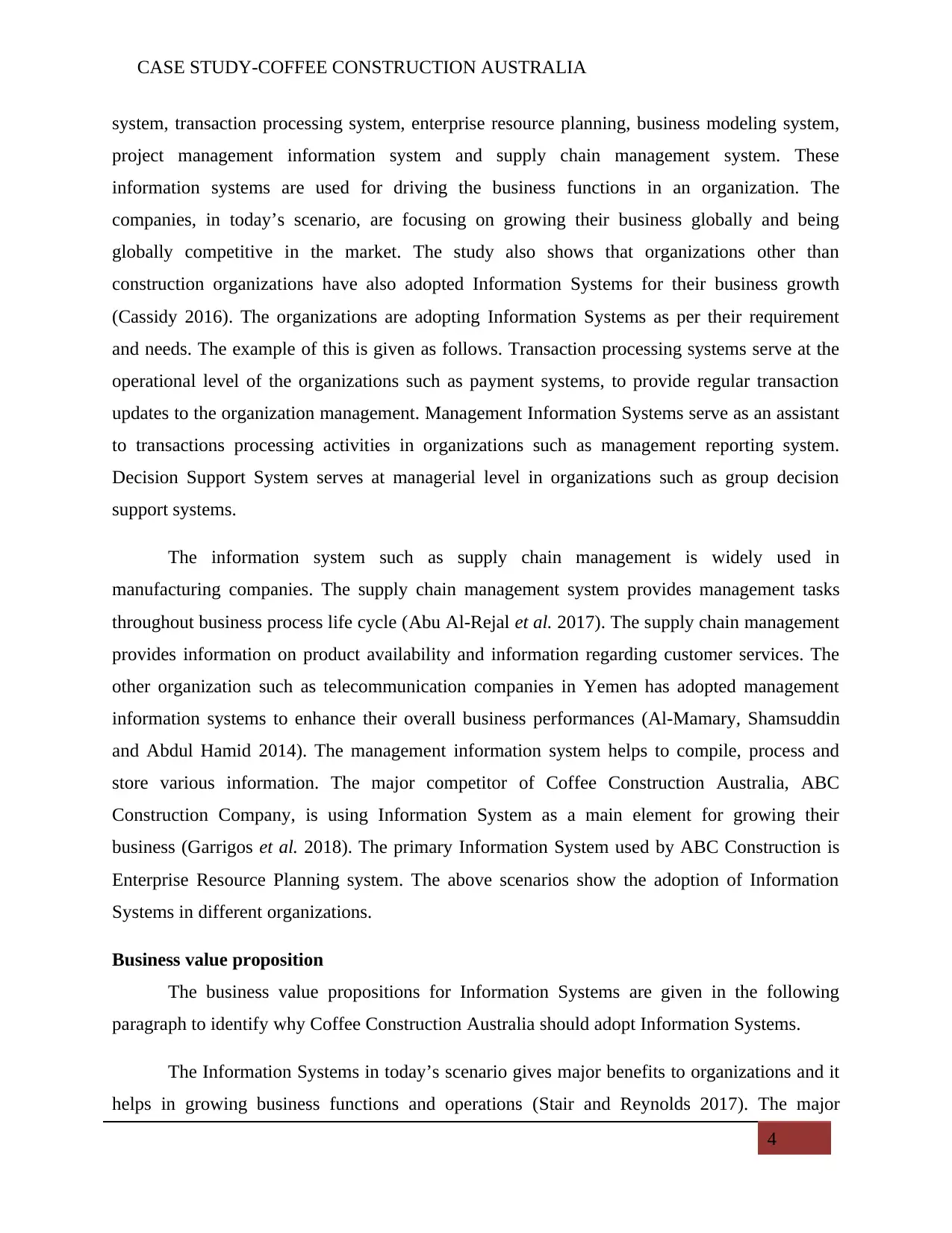
CASE STUDY-COFFEE CONSTRUCTION AUSTRALIA
system, transaction processing system, enterprise resource planning, business modeling system,
project management information system and supply chain management system. These
information systems are used for driving the business functions in an organization. The
companies, in today’s scenario, are focusing on growing their business globally and being
globally competitive in the market. The study also shows that organizations other than
construction organizations have also adopted Information Systems for their business growth
(Cassidy 2016). The organizations are adopting Information Systems as per their requirement
and needs. The example of this is given as follows. Transaction processing systems serve at the
operational level of the organizations such as payment systems, to provide regular transaction
updates to the organization management. Management Information Systems serve as an assistant
to transactions processing activities in organizations such as management reporting system.
Decision Support System serves at managerial level in organizations such as group decision
support systems.
The information system such as supply chain management is widely used in
manufacturing companies. The supply chain management system provides management tasks
throughout business process life cycle (Abu Al-Rejal et al. 2017). The supply chain management
provides information on product availability and information regarding customer services. The
other organization such as telecommunication companies in Yemen has adopted management
information systems to enhance their overall business performances (Al-Mamary, Shamsuddin
and Abdul Hamid 2014). The management information system helps to compile, process and
store various information. The major competitor of Coffee Construction Australia, ABC
Construction Company, is using Information System as a main element for growing their
business (Garrigos et al. 2018). The primary Information System used by ABC Construction is
Enterprise Resource Planning system. The above scenarios show the adoption of Information
Systems in different organizations.
Business value proposition
The business value propositions for Information Systems are given in the following
paragraph to identify why Coffee Construction Australia should adopt Information Systems.
The Information Systems in today’s scenario gives major benefits to organizations and it
helps in growing business functions and operations (Stair and Reynolds 2017). The major
4
system, transaction processing system, enterprise resource planning, business modeling system,
project management information system and supply chain management system. These
information systems are used for driving the business functions in an organization. The
companies, in today’s scenario, are focusing on growing their business globally and being
globally competitive in the market. The study also shows that organizations other than
construction organizations have also adopted Information Systems for their business growth
(Cassidy 2016). The organizations are adopting Information Systems as per their requirement
and needs. The example of this is given as follows. Transaction processing systems serve at the
operational level of the organizations such as payment systems, to provide regular transaction
updates to the organization management. Management Information Systems serve as an assistant
to transactions processing activities in organizations such as management reporting system.
Decision Support System serves at managerial level in organizations such as group decision
support systems.
The information system such as supply chain management is widely used in
manufacturing companies. The supply chain management system provides management tasks
throughout business process life cycle (Abu Al-Rejal et al. 2017). The supply chain management
provides information on product availability and information regarding customer services. The
other organization such as telecommunication companies in Yemen has adopted management
information systems to enhance their overall business performances (Al-Mamary, Shamsuddin
and Abdul Hamid 2014). The management information system helps to compile, process and
store various information. The major competitor of Coffee Construction Australia, ABC
Construction Company, is using Information System as a main element for growing their
business (Garrigos et al. 2018). The primary Information System used by ABC Construction is
Enterprise Resource Planning system. The above scenarios show the adoption of Information
Systems in different organizations.
Business value proposition
The business value propositions for Information Systems are given in the following
paragraph to identify why Coffee Construction Australia should adopt Information Systems.
The Information Systems in today’s scenario gives major benefits to organizations and it
helps in growing business functions and operations (Stair and Reynolds 2017). The major
4
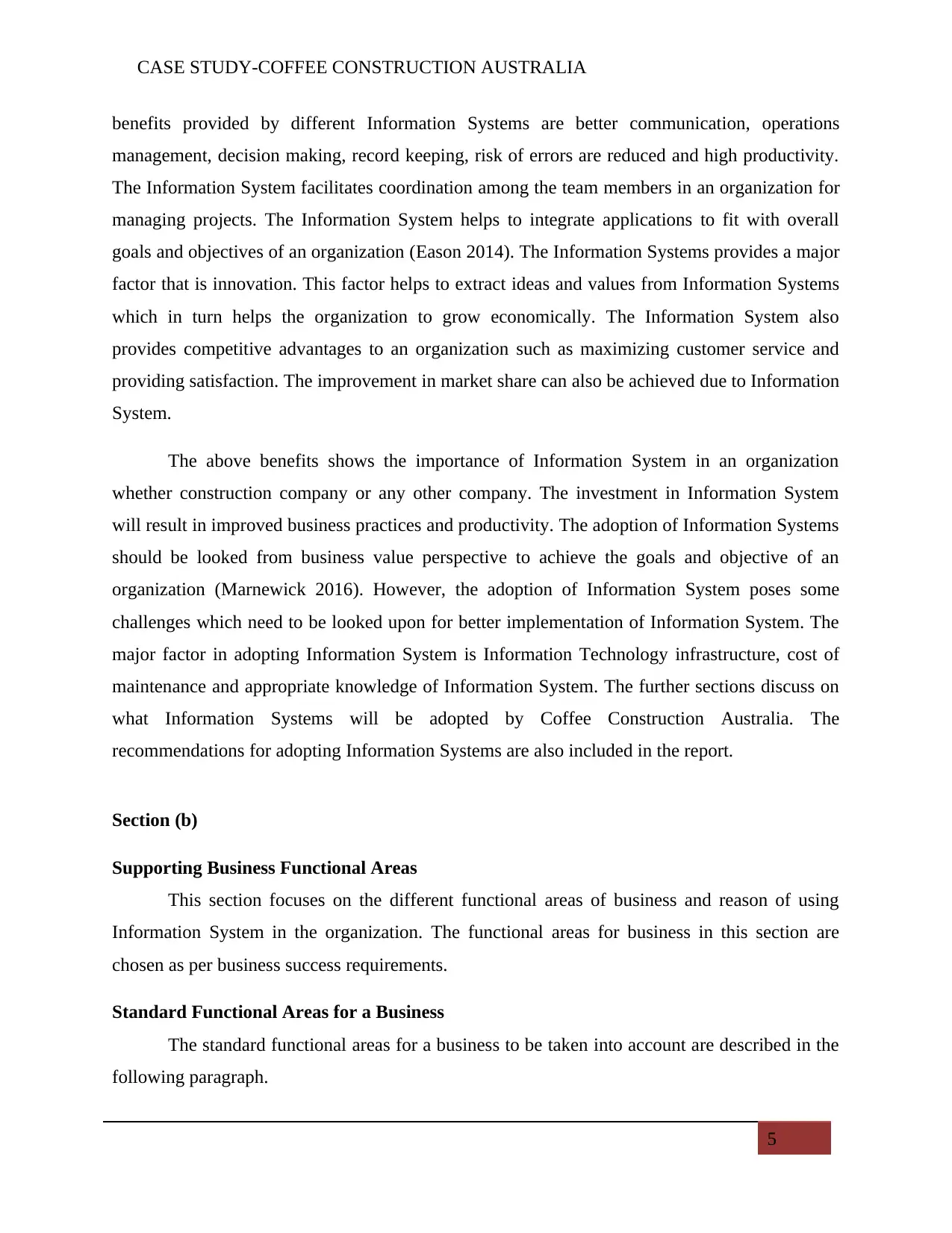
CASE STUDY-COFFEE CONSTRUCTION AUSTRALIA
benefits provided by different Information Systems are better communication, operations
management, decision making, record keeping, risk of errors are reduced and high productivity.
The Information System facilitates coordination among the team members in an organization for
managing projects. The Information System helps to integrate applications to fit with overall
goals and objectives of an organization (Eason 2014). The Information Systems provides a major
factor that is innovation. This factor helps to extract ideas and values from Information Systems
which in turn helps the organization to grow economically. The Information System also
provides competitive advantages to an organization such as maximizing customer service and
providing satisfaction. The improvement in market share can also be achieved due to Information
System.
The above benefits shows the importance of Information System in an organization
whether construction company or any other company. The investment in Information System
will result in improved business practices and productivity. The adoption of Information Systems
should be looked from business value perspective to achieve the goals and objective of an
organization (Marnewick 2016). However, the adoption of Information System poses some
challenges which need to be looked upon for better implementation of Information System. The
major factor in adopting Information System is Information Technology infrastructure, cost of
maintenance and appropriate knowledge of Information System. The further sections discuss on
what Information Systems will be adopted by Coffee Construction Australia. The
recommendations for adopting Information Systems are also included in the report.
Section (b)
Supporting Business Functional Areas
This section focuses on the different functional areas of business and reason of using
Information System in the organization. The functional areas for business in this section are
chosen as per business success requirements.
Standard Functional Areas for a Business
The standard functional areas for a business to be taken into account are described in the
following paragraph.
5
benefits provided by different Information Systems are better communication, operations
management, decision making, record keeping, risk of errors are reduced and high productivity.
The Information System facilitates coordination among the team members in an organization for
managing projects. The Information System helps to integrate applications to fit with overall
goals and objectives of an organization (Eason 2014). The Information Systems provides a major
factor that is innovation. This factor helps to extract ideas and values from Information Systems
which in turn helps the organization to grow economically. The Information System also
provides competitive advantages to an organization such as maximizing customer service and
providing satisfaction. The improvement in market share can also be achieved due to Information
System.
The above benefits shows the importance of Information System in an organization
whether construction company or any other company. The investment in Information System
will result in improved business practices and productivity. The adoption of Information Systems
should be looked from business value perspective to achieve the goals and objective of an
organization (Marnewick 2016). However, the adoption of Information System poses some
challenges which need to be looked upon for better implementation of Information System. The
major factor in adopting Information System is Information Technology infrastructure, cost of
maintenance and appropriate knowledge of Information System. The further sections discuss on
what Information Systems will be adopted by Coffee Construction Australia. The
recommendations for adopting Information Systems are also included in the report.
Section (b)
Supporting Business Functional Areas
This section focuses on the different functional areas of business and reason of using
Information System in the organization. The functional areas for business in this section are
chosen as per business success requirements.
Standard Functional Areas for a Business
The standard functional areas for a business to be taken into account are described in the
following paragraph.
5
⊘ This is a preview!⊘
Do you want full access?
Subscribe today to unlock all pages.

Trusted by 1+ million students worldwide
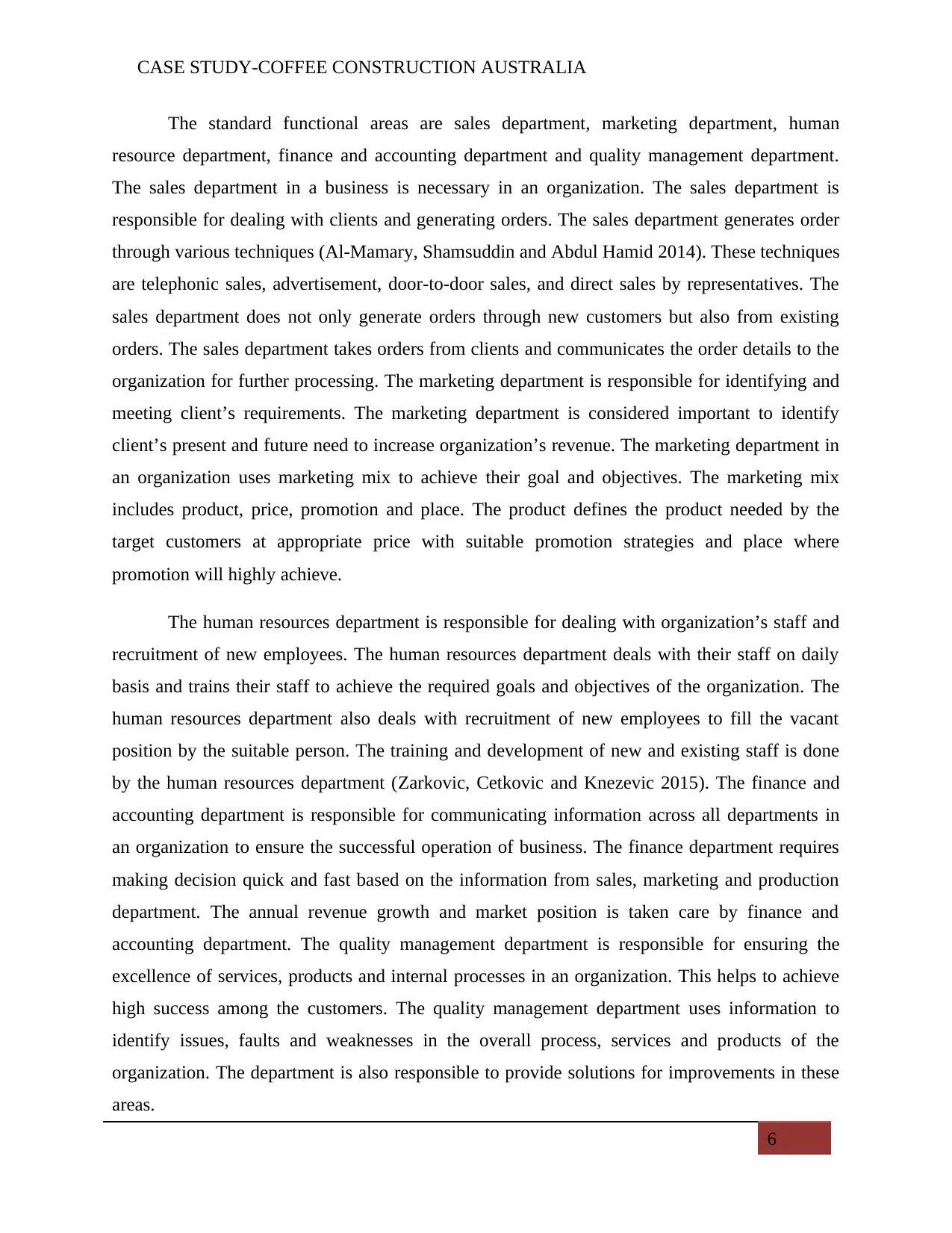
CASE STUDY-COFFEE CONSTRUCTION AUSTRALIA
The standard functional areas are sales department, marketing department, human
resource department, finance and accounting department and quality management department.
The sales department in a business is necessary in an organization. The sales department is
responsible for dealing with clients and generating orders. The sales department generates order
through various techniques (Al-Mamary, Shamsuddin and Abdul Hamid 2014). These techniques
are telephonic sales, advertisement, door-to-door sales, and direct sales by representatives. The
sales department does not only generate orders through new customers but also from existing
orders. The sales department takes orders from clients and communicates the order details to the
organization for further processing. The marketing department is responsible for identifying and
meeting client’s requirements. The marketing department is considered important to identify
client’s present and future need to increase organization’s revenue. The marketing department in
an organization uses marketing mix to achieve their goal and objectives. The marketing mix
includes product, price, promotion and place. The product defines the product needed by the
target customers at appropriate price with suitable promotion strategies and place where
promotion will highly achieve.
The human resources department is responsible for dealing with organization’s staff and
recruitment of new employees. The human resources department deals with their staff on daily
basis and trains their staff to achieve the required goals and objectives of the organization. The
human resources department also deals with recruitment of new employees to fill the vacant
position by the suitable person. The training and development of new and existing staff is done
by the human resources department (Zarkovic, Cetkovic and Knezevic 2015). The finance and
accounting department is responsible for communicating information across all departments in
an organization to ensure the successful operation of business. The finance department requires
making decision quick and fast based on the information from sales, marketing and production
department. The annual revenue growth and market position is taken care by finance and
accounting department. The quality management department is responsible for ensuring the
excellence of services, products and internal processes in an organization. This helps to achieve
high success among the customers. The quality management department uses information to
identify issues, faults and weaknesses in the overall process, services and products of the
organization. The department is also responsible to provide solutions for improvements in these
areas.
6
The standard functional areas are sales department, marketing department, human
resource department, finance and accounting department and quality management department.
The sales department in a business is necessary in an organization. The sales department is
responsible for dealing with clients and generating orders. The sales department generates order
through various techniques (Al-Mamary, Shamsuddin and Abdul Hamid 2014). These techniques
are telephonic sales, advertisement, door-to-door sales, and direct sales by representatives. The
sales department does not only generate orders through new customers but also from existing
orders. The sales department takes orders from clients and communicates the order details to the
organization for further processing. The marketing department is responsible for identifying and
meeting client’s requirements. The marketing department is considered important to identify
client’s present and future need to increase organization’s revenue. The marketing department in
an organization uses marketing mix to achieve their goal and objectives. The marketing mix
includes product, price, promotion and place. The product defines the product needed by the
target customers at appropriate price with suitable promotion strategies and place where
promotion will highly achieve.
The human resources department is responsible for dealing with organization’s staff and
recruitment of new employees. The human resources department deals with their staff on daily
basis and trains their staff to achieve the required goals and objectives of the organization. The
human resources department also deals with recruitment of new employees to fill the vacant
position by the suitable person. The training and development of new and existing staff is done
by the human resources department (Zarkovic, Cetkovic and Knezevic 2015). The finance and
accounting department is responsible for communicating information across all departments in
an organization to ensure the successful operation of business. The finance department requires
making decision quick and fast based on the information from sales, marketing and production
department. The annual revenue growth and market position is taken care by finance and
accounting department. The quality management department is responsible for ensuring the
excellence of services, products and internal processes in an organization. This helps to achieve
high success among the customers. The quality management department uses information to
identify issues, faults and weaknesses in the overall process, services and products of the
organization. The department is also responsible to provide solutions for improvements in these
areas.
6
Paraphrase This Document
Need a fresh take? Get an instant paraphrase of this document with our AI Paraphraser
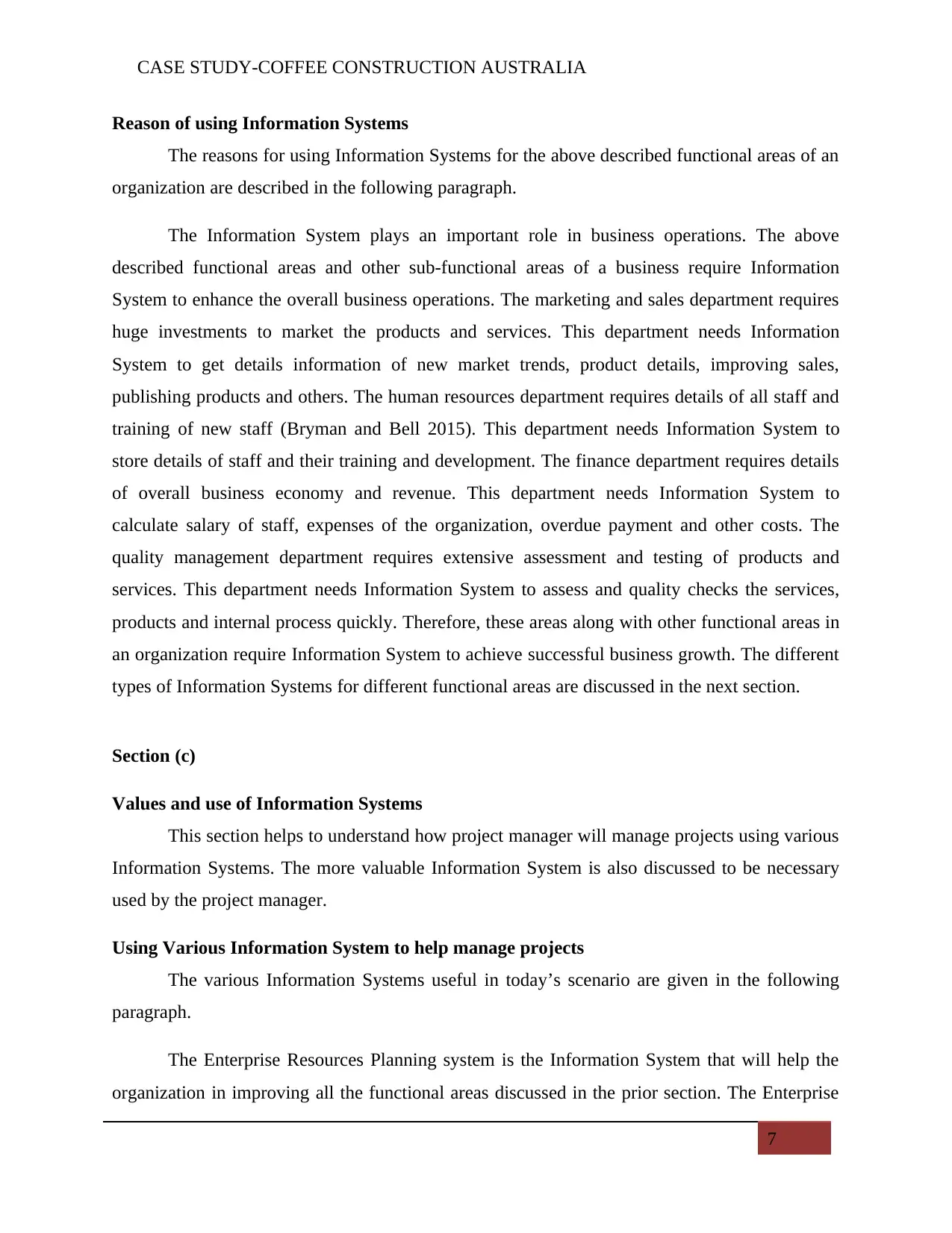
CASE STUDY-COFFEE CONSTRUCTION AUSTRALIA
Reason of using Information Systems
The reasons for using Information Systems for the above described functional areas of an
organization are described in the following paragraph.
The Information System plays an important role in business operations. The above
described functional areas and other sub-functional areas of a business require Information
System to enhance the overall business operations. The marketing and sales department requires
huge investments to market the products and services. This department needs Information
System to get details information of new market trends, product details, improving sales,
publishing products and others. The human resources department requires details of all staff and
training of new staff (Bryman and Bell 2015). This department needs Information System to
store details of staff and their training and development. The finance department requires details
of overall business economy and revenue. This department needs Information System to
calculate salary of staff, expenses of the organization, overdue payment and other costs. The
quality management department requires extensive assessment and testing of products and
services. This department needs Information System to assess and quality checks the services,
products and internal process quickly. Therefore, these areas along with other functional areas in
an organization require Information System to achieve successful business growth. The different
types of Information Systems for different functional areas are discussed in the next section.
Section (c)
Values and use of Information Systems
This section helps to understand how project manager will manage projects using various
Information Systems. The more valuable Information System is also discussed to be necessary
used by the project manager.
Using Various Information System to help manage projects
The various Information Systems useful in today’s scenario are given in the following
paragraph.
The Enterprise Resources Planning system is the Information System that will help the
organization in improving all the functional areas discussed in the prior section. The Enterprise
7
Reason of using Information Systems
The reasons for using Information Systems for the above described functional areas of an
organization are described in the following paragraph.
The Information System plays an important role in business operations. The above
described functional areas and other sub-functional areas of a business require Information
System to enhance the overall business operations. The marketing and sales department requires
huge investments to market the products and services. This department needs Information
System to get details information of new market trends, product details, improving sales,
publishing products and others. The human resources department requires details of all staff and
training of new staff (Bryman and Bell 2015). This department needs Information System to
store details of staff and their training and development. The finance department requires details
of overall business economy and revenue. This department needs Information System to
calculate salary of staff, expenses of the organization, overdue payment and other costs. The
quality management department requires extensive assessment and testing of products and
services. This department needs Information System to assess and quality checks the services,
products and internal process quickly. Therefore, these areas along with other functional areas in
an organization require Information System to achieve successful business growth. The different
types of Information Systems for different functional areas are discussed in the next section.
Section (c)
Values and use of Information Systems
This section helps to understand how project manager will manage projects using various
Information Systems. The more valuable Information System is also discussed to be necessary
used by the project manager.
Using Various Information System to help manage projects
The various Information Systems useful in today’s scenario are given in the following
paragraph.
The Enterprise Resources Planning system is the Information System that will help the
organization in improving all the functional areas discussed in the prior section. The Enterprise
7
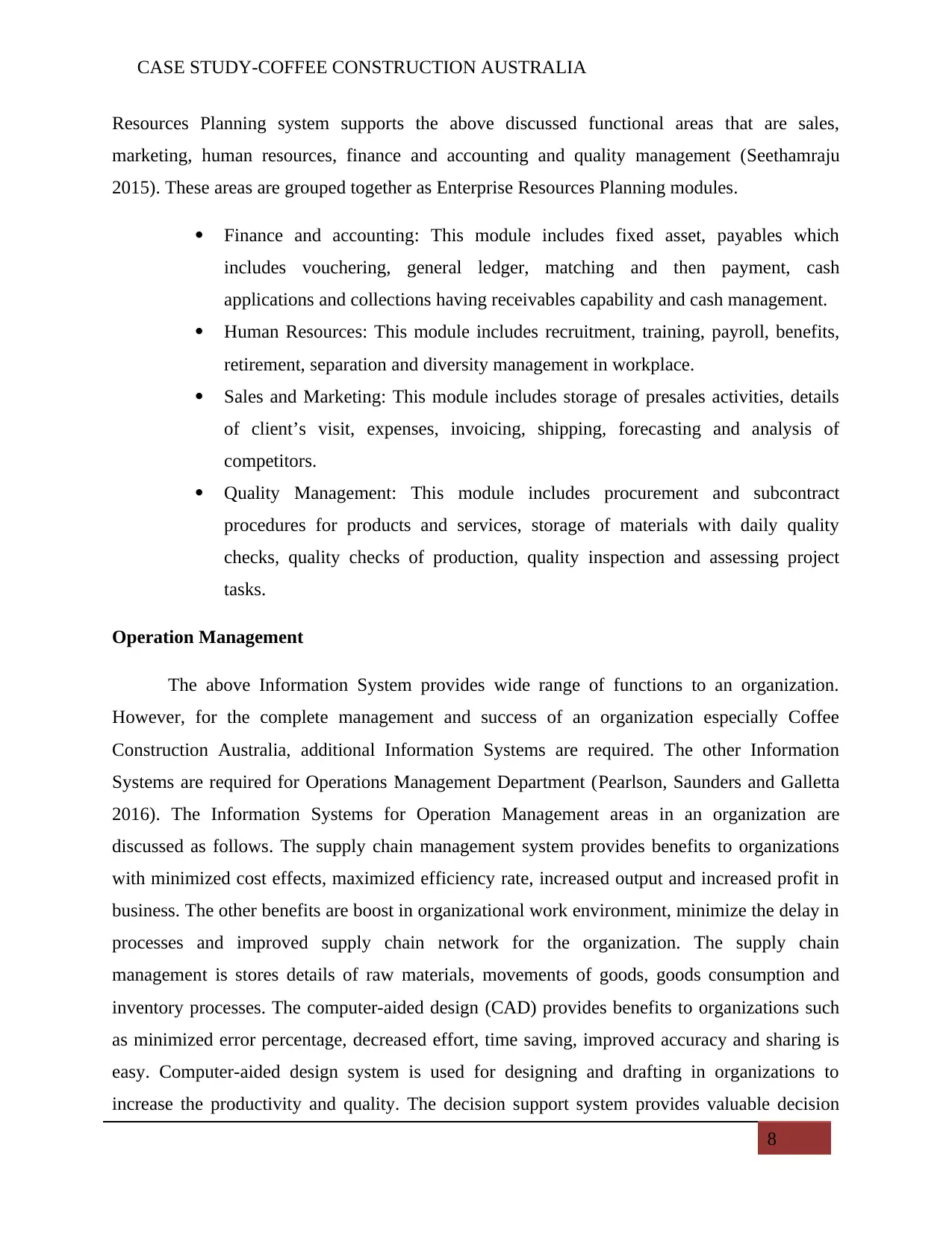
CASE STUDY-COFFEE CONSTRUCTION AUSTRALIA
Resources Planning system supports the above discussed functional areas that are sales,
marketing, human resources, finance and accounting and quality management (Seethamraju
2015). These areas are grouped together as Enterprise Resources Planning modules.
Finance and accounting: This module includes fixed asset, payables which
includes vouchering, general ledger, matching and then payment, cash
applications and collections having receivables capability and cash management.
Human Resources: This module includes recruitment, training, payroll, benefits,
retirement, separation and diversity management in workplace.
Sales and Marketing: This module includes storage of presales activities, details
of client’s visit, expenses, invoicing, shipping, forecasting and analysis of
competitors.
Quality Management: This module includes procurement and subcontract
procedures for products and services, storage of materials with daily quality
checks, quality checks of production, quality inspection and assessing project
tasks.
Operation Management
The above Information System provides wide range of functions to an organization.
However, for the complete management and success of an organization especially Coffee
Construction Australia, additional Information Systems are required. The other Information
Systems are required for Operations Management Department (Pearlson, Saunders and Galletta
2016). The Information Systems for Operation Management areas in an organization are
discussed as follows. The supply chain management system provides benefits to organizations
with minimized cost effects, maximized efficiency rate, increased output and increased profit in
business. The other benefits are boost in organizational work environment, minimize the delay in
processes and improved supply chain network for the organization. The supply chain
management is stores details of raw materials, movements of goods, goods consumption and
inventory processes. The computer-aided design (CAD) provides benefits to organizations such
as minimized error percentage, decreased effort, time saving, improved accuracy and sharing is
easy. Computer-aided design system is used for designing and drafting in organizations to
increase the productivity and quality. The decision support system provides valuable decision
8
Resources Planning system supports the above discussed functional areas that are sales,
marketing, human resources, finance and accounting and quality management (Seethamraju
2015). These areas are grouped together as Enterprise Resources Planning modules.
Finance and accounting: This module includes fixed asset, payables which
includes vouchering, general ledger, matching and then payment, cash
applications and collections having receivables capability and cash management.
Human Resources: This module includes recruitment, training, payroll, benefits,
retirement, separation and diversity management in workplace.
Sales and Marketing: This module includes storage of presales activities, details
of client’s visit, expenses, invoicing, shipping, forecasting and analysis of
competitors.
Quality Management: This module includes procurement and subcontract
procedures for products and services, storage of materials with daily quality
checks, quality checks of production, quality inspection and assessing project
tasks.
Operation Management
The above Information System provides wide range of functions to an organization.
However, for the complete management and success of an organization especially Coffee
Construction Australia, additional Information Systems are required. The other Information
Systems are required for Operations Management Department (Pearlson, Saunders and Galletta
2016). The Information Systems for Operation Management areas in an organization are
discussed as follows. The supply chain management system provides benefits to organizations
with minimized cost effects, maximized efficiency rate, increased output and increased profit in
business. The other benefits are boost in organizational work environment, minimize the delay in
processes and improved supply chain network for the organization. The supply chain
management is stores details of raw materials, movements of goods, goods consumption and
inventory processes. The computer-aided design (CAD) provides benefits to organizations such
as minimized error percentage, decreased effort, time saving, improved accuracy and sharing is
easy. Computer-aided design system is used for designing and drafting in organizations to
increase the productivity and quality. The decision support system provides valuable decision
8
⊘ This is a preview!⊘
Do you want full access?
Subscribe today to unlock all pages.

Trusted by 1+ million students worldwide
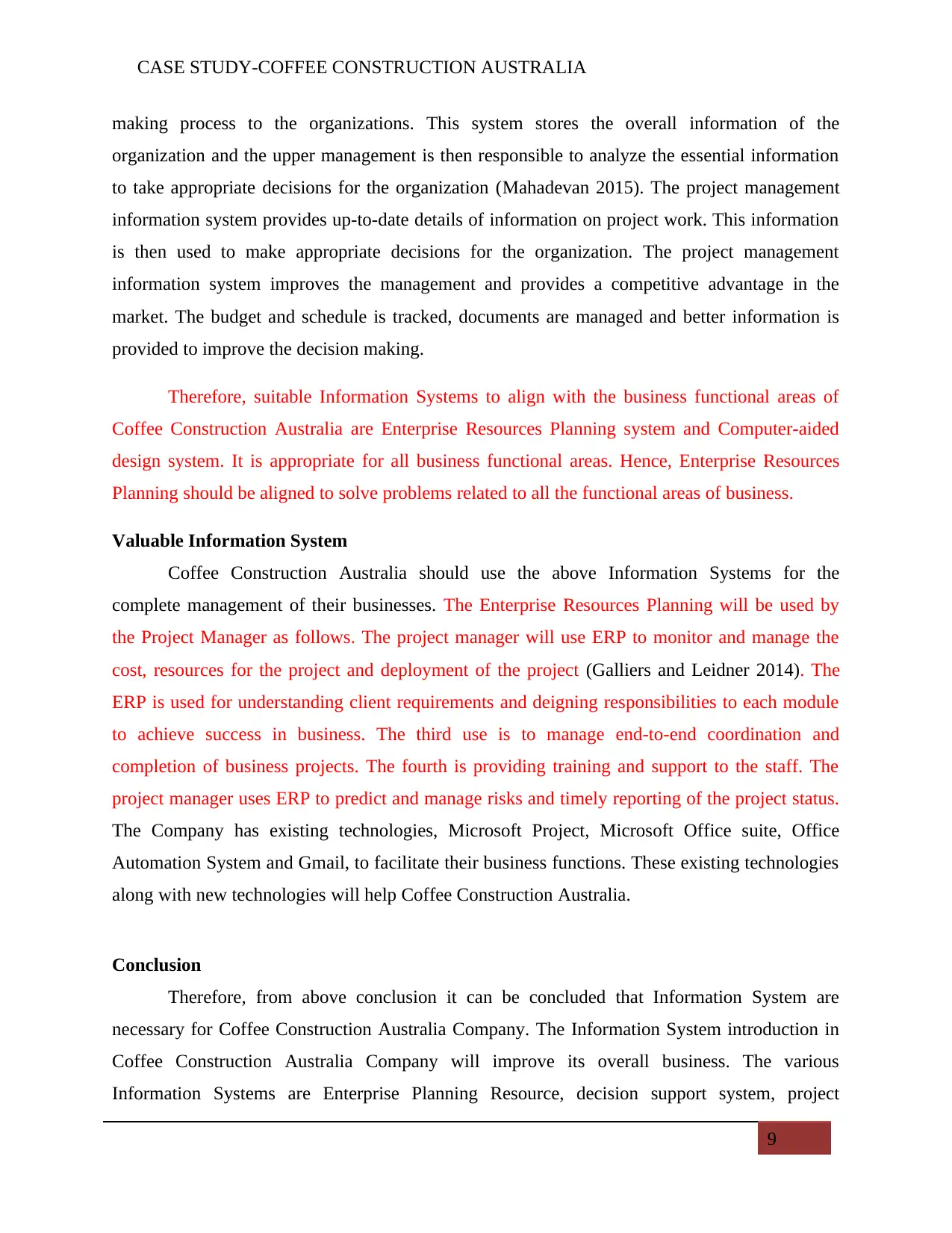
CASE STUDY-COFFEE CONSTRUCTION AUSTRALIA
making process to the organizations. This system stores the overall information of the
organization and the upper management is then responsible to analyze the essential information
to take appropriate decisions for the organization (Mahadevan 2015). The project management
information system provides up-to-date details of information on project work. This information
is then used to make appropriate decisions for the organization. The project management
information system improves the management and provides a competitive advantage in the
market. The budget and schedule is tracked, documents are managed and better information is
provided to improve the decision making.
Therefore, suitable Information Systems to align with the business functional areas of
Coffee Construction Australia are Enterprise Resources Planning system and Computer-aided
design system. It is appropriate for all business functional areas. Hence, Enterprise Resources
Planning should be aligned to solve problems related to all the functional areas of business.
Valuable Information System
Coffee Construction Australia should use the above Information Systems for the
complete management of their businesses. The Enterprise Resources Planning will be used by
the Project Manager as follows. The project manager will use ERP to monitor and manage the
cost, resources for the project and deployment of the project (Galliers and Leidner 2014). The
ERP is used for understanding client requirements and deigning responsibilities to each module
to achieve success in business. The third use is to manage end-to-end coordination and
completion of business projects. The fourth is providing training and support to the staff. The
project manager uses ERP to predict and manage risks and timely reporting of the project status.
The Company has existing technologies, Microsoft Project, Microsoft Office suite, Office
Automation System and Gmail, to facilitate their business functions. These existing technologies
along with new technologies will help Coffee Construction Australia.
Conclusion
Therefore, from above conclusion it can be concluded that Information System are
necessary for Coffee Construction Australia Company. The Information System introduction in
Coffee Construction Australia Company will improve its overall business. The various
Information Systems are Enterprise Planning Resource, decision support system, project
9
making process to the organizations. This system stores the overall information of the
organization and the upper management is then responsible to analyze the essential information
to take appropriate decisions for the organization (Mahadevan 2015). The project management
information system provides up-to-date details of information on project work. This information
is then used to make appropriate decisions for the organization. The project management
information system improves the management and provides a competitive advantage in the
market. The budget and schedule is tracked, documents are managed and better information is
provided to improve the decision making.
Therefore, suitable Information Systems to align with the business functional areas of
Coffee Construction Australia are Enterprise Resources Planning system and Computer-aided
design system. It is appropriate for all business functional areas. Hence, Enterprise Resources
Planning should be aligned to solve problems related to all the functional areas of business.
Valuable Information System
Coffee Construction Australia should use the above Information Systems for the
complete management of their businesses. The Enterprise Resources Planning will be used by
the Project Manager as follows. The project manager will use ERP to monitor and manage the
cost, resources for the project and deployment of the project (Galliers and Leidner 2014). The
ERP is used for understanding client requirements and deigning responsibilities to each module
to achieve success in business. The third use is to manage end-to-end coordination and
completion of business projects. The fourth is providing training and support to the staff. The
project manager uses ERP to predict and manage risks and timely reporting of the project status.
The Company has existing technologies, Microsoft Project, Microsoft Office suite, Office
Automation System and Gmail, to facilitate their business functions. These existing technologies
along with new technologies will help Coffee Construction Australia.
Conclusion
Therefore, from above conclusion it can be concluded that Information System are
necessary for Coffee Construction Australia Company. The Information System introduction in
Coffee Construction Australia Company will improve its overall business. The various
Information Systems are Enterprise Planning Resource, decision support system, project
9
Paraphrase This Document
Need a fresh take? Get an instant paraphrase of this document with our AI Paraphraser
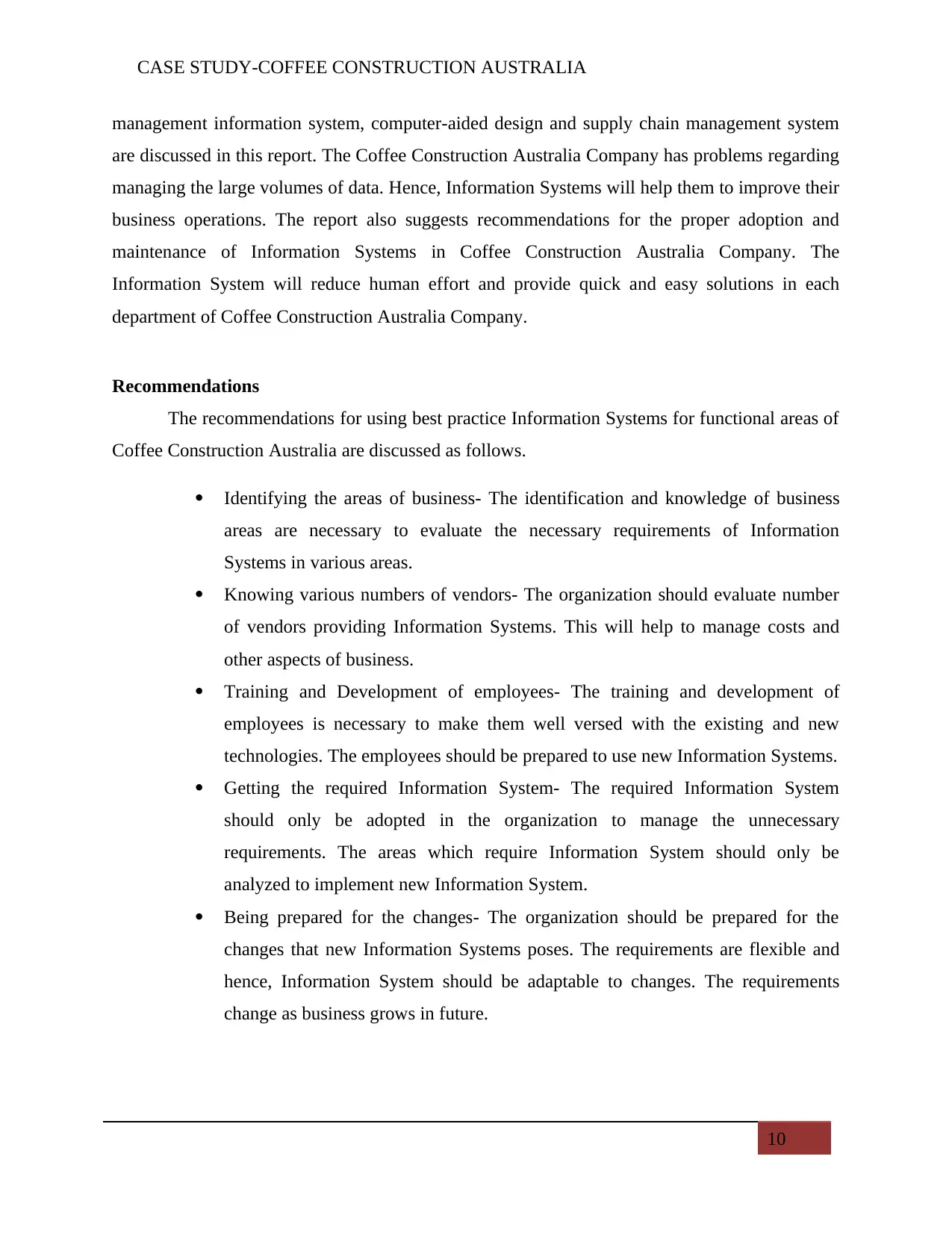
CASE STUDY-COFFEE CONSTRUCTION AUSTRALIA
management information system, computer-aided design and supply chain management system
are discussed in this report. The Coffee Construction Australia Company has problems regarding
managing the large volumes of data. Hence, Information Systems will help them to improve their
business operations. The report also suggests recommendations for the proper adoption and
maintenance of Information Systems in Coffee Construction Australia Company. The
Information System will reduce human effort and provide quick and easy solutions in each
department of Coffee Construction Australia Company.
Recommendations
The recommendations for using best practice Information Systems for functional areas of
Coffee Construction Australia are discussed as follows.
Identifying the areas of business- The identification and knowledge of business
areas are necessary to evaluate the necessary requirements of Information
Systems in various areas.
Knowing various numbers of vendors- The organization should evaluate number
of vendors providing Information Systems. This will help to manage costs and
other aspects of business.
Training and Development of employees- The training and development of
employees is necessary to make them well versed with the existing and new
technologies. The employees should be prepared to use new Information Systems.
Getting the required Information System- The required Information System
should only be adopted in the organization to manage the unnecessary
requirements. The areas which require Information System should only be
analyzed to implement new Information System.
Being prepared for the changes- The organization should be prepared for the
changes that new Information Systems poses. The requirements are flexible and
hence, Information System should be adaptable to changes. The requirements
change as business grows in future.
10
management information system, computer-aided design and supply chain management system
are discussed in this report. The Coffee Construction Australia Company has problems regarding
managing the large volumes of data. Hence, Information Systems will help them to improve their
business operations. The report also suggests recommendations for the proper adoption and
maintenance of Information Systems in Coffee Construction Australia Company. The
Information System will reduce human effort and provide quick and easy solutions in each
department of Coffee Construction Australia Company.
Recommendations
The recommendations for using best practice Information Systems for functional areas of
Coffee Construction Australia are discussed as follows.
Identifying the areas of business- The identification and knowledge of business
areas are necessary to evaluate the necessary requirements of Information
Systems in various areas.
Knowing various numbers of vendors- The organization should evaluate number
of vendors providing Information Systems. This will help to manage costs and
other aspects of business.
Training and Development of employees- The training and development of
employees is necessary to make them well versed with the existing and new
technologies. The employees should be prepared to use new Information Systems.
Getting the required Information System- The required Information System
should only be adopted in the organization to manage the unnecessary
requirements. The areas which require Information System should only be
analyzed to implement new Information System.
Being prepared for the changes- The organization should be prepared for the
changes that new Information Systems poses. The requirements are flexible and
hence, Information System should be adaptable to changes. The requirements
change as business grows in future.
10
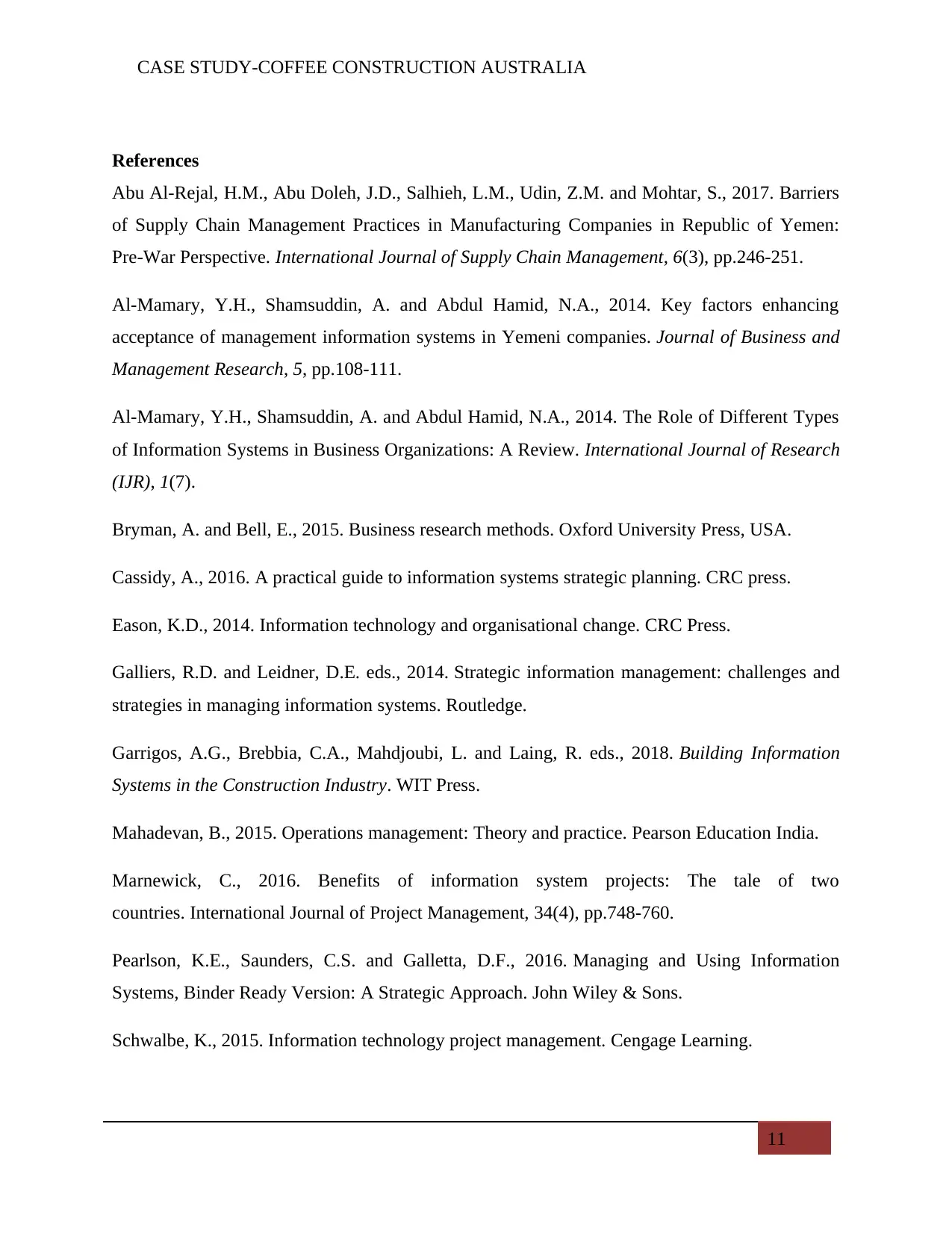
CASE STUDY-COFFEE CONSTRUCTION AUSTRALIA
References
Abu Al-Rejal, H.M., Abu Doleh, J.D., Salhieh, L.M., Udin, Z.M. and Mohtar, S., 2017. Barriers
of Supply Chain Management Practices in Manufacturing Companies in Republic of Yemen:
Pre-War Perspective. International Journal of Supply Chain Management, 6(3), pp.246-251.
Al-Mamary, Y.H., Shamsuddin, A. and Abdul Hamid, N.A., 2014. Key factors enhancing
acceptance of management information systems in Yemeni companies. Journal of Business and
Management Research, 5, pp.108-111.
Al-Mamary, Y.H., Shamsuddin, A. and Abdul Hamid, N.A., 2014. The Role of Different Types
of Information Systems in Business Organizations: A Review. International Journal of Research
(IJR), 1(7).
Bryman, A. and Bell, E., 2015. Business research methods. Oxford University Press, USA.
Cassidy, A., 2016. A practical guide to information systems strategic planning. CRC press.
Eason, K.D., 2014. Information technology and organisational change. CRC Press.
Galliers, R.D. and Leidner, D.E. eds., 2014. Strategic information management: challenges and
strategies in managing information systems. Routledge.
Garrigos, A.G., Brebbia, C.A., Mahdjoubi, L. and Laing, R. eds., 2018. Building Information
Systems in the Construction Industry. WIT Press.
Mahadevan, B., 2015. Operations management: Theory and practice. Pearson Education India.
Marnewick, C., 2016. Benefits of information system projects: The tale of two
countries. International Journal of Project Management, 34(4), pp.748-760.
Pearlson, K.E., Saunders, C.S. and Galletta, D.F., 2016. Managing and Using Information
Systems, Binder Ready Version: A Strategic Approach. John Wiley & Sons.
Schwalbe, K., 2015. Information technology project management. Cengage Learning.
11
References
Abu Al-Rejal, H.M., Abu Doleh, J.D., Salhieh, L.M., Udin, Z.M. and Mohtar, S., 2017. Barriers
of Supply Chain Management Practices in Manufacturing Companies in Republic of Yemen:
Pre-War Perspective. International Journal of Supply Chain Management, 6(3), pp.246-251.
Al-Mamary, Y.H., Shamsuddin, A. and Abdul Hamid, N.A., 2014. Key factors enhancing
acceptance of management information systems in Yemeni companies. Journal of Business and
Management Research, 5, pp.108-111.
Al-Mamary, Y.H., Shamsuddin, A. and Abdul Hamid, N.A., 2014. The Role of Different Types
of Information Systems in Business Organizations: A Review. International Journal of Research
(IJR), 1(7).
Bryman, A. and Bell, E., 2015. Business research methods. Oxford University Press, USA.
Cassidy, A., 2016. A practical guide to information systems strategic planning. CRC press.
Eason, K.D., 2014. Information technology and organisational change. CRC Press.
Galliers, R.D. and Leidner, D.E. eds., 2014. Strategic information management: challenges and
strategies in managing information systems. Routledge.
Garrigos, A.G., Brebbia, C.A., Mahdjoubi, L. and Laing, R. eds., 2018. Building Information
Systems in the Construction Industry. WIT Press.
Mahadevan, B., 2015. Operations management: Theory and practice. Pearson Education India.
Marnewick, C., 2016. Benefits of information system projects: The tale of two
countries. International Journal of Project Management, 34(4), pp.748-760.
Pearlson, K.E., Saunders, C.S. and Galletta, D.F., 2016. Managing and Using Information
Systems, Binder Ready Version: A Strategic Approach. John Wiley & Sons.
Schwalbe, K., 2015. Information technology project management. Cengage Learning.
11
⊘ This is a preview!⊘
Do you want full access?
Subscribe today to unlock all pages.

Trusted by 1+ million students worldwide
1 out of 13
Related Documents
Your All-in-One AI-Powered Toolkit for Academic Success.
+13062052269
info@desklib.com
Available 24*7 on WhatsApp / Email
![[object Object]](/_next/static/media/star-bottom.7253800d.svg)
Unlock your academic potential
Copyright © 2020–2025 A2Z Services. All Rights Reserved. Developed and managed by ZUCOL.





